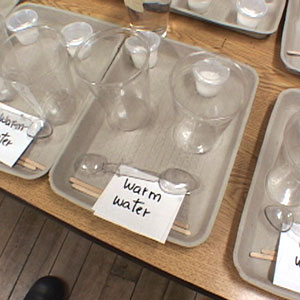Join us for conversations that inspire, recognize, and encourage innovation and best practices in the education profession.
Available on Apple Podcasts, Spotify, Google Podcasts, and more.

Dissolving activity preparation.
During this session, you will have an opportunity to build understandings to help you:
In everyday life, observations that things “disappear” or “appear” seem to contradict one of the fundamental laws of nature: matter can be neither created nor destroyed. This session explores various manifestations of the law, and builds on the particle model of matter to explain physical changes.
What happens when sugar is dissolved in a glass of water? When a pot of water on the stove boils away? Do things ever really “disappear”? The video opens with children in the Science Studio observing a common magic trick in which matter seems to disappear. As they try to follow the button that vanishes from their field of vision, the ideas they express about “where things go” become the recurrent theme as they and other children explore what happens to matter through a series of physical changes like melting, mixing, and dissolving. Which principles of the particle model apply to these changes?
We continue in the Science Studio where two students investigate the principle of conservation of matter using building blocks and the evaporation of alcohol, and other children grapple with the reversibility of physical changes.
Technicians Ark Pang and Peter Schuerch introduce us to the desalination of water, a real-world application of the separation of solutions. We then visit the Benjamin Banneker Charter School in Cambridge, Massachusetts, where Rosinda Almeida’s second graders are exploring the effect of heat on the dissolving process. The session ends with a puzzle—how can the volumes of two liquids that are mixed together and shaken decrease, while their weight remains constant before and after the shaking?